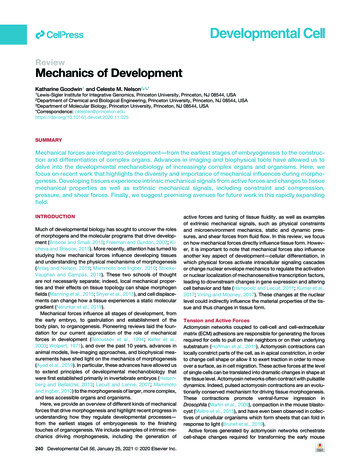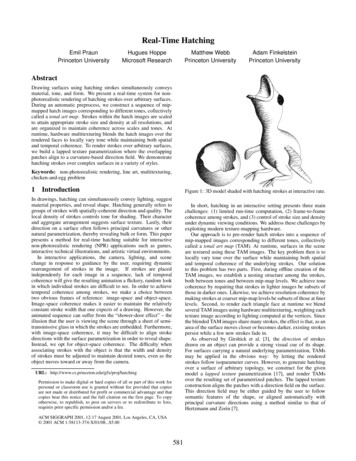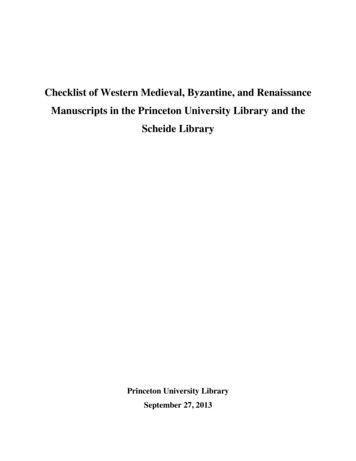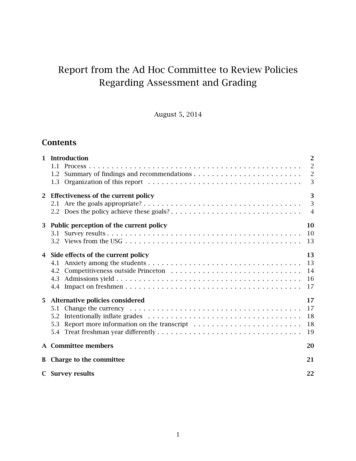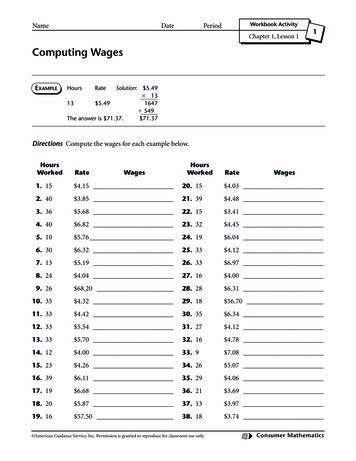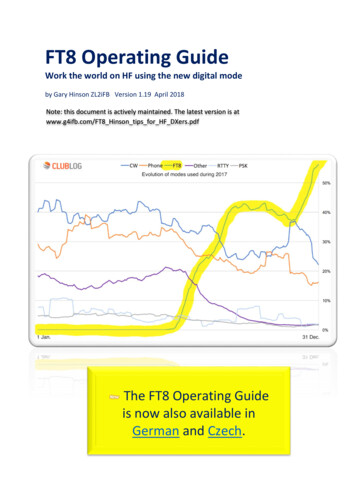
Transcription
FT8 Operating GuideWork the world on HF using the new digital modeby Gary Hinson ZL2iFB Version 1.19 April 2018Note: this document is actively maintained. The latest version is atwww.g4ifb.com/FT8 Hinson tips for HF DXers.pdfThe FT8 Operating Guideis now also available inGerman and Czech.
FT8 Operating GuideFT8 Operating GuideBy Gary Hinson ZL2iFB Version 1.19 April 20181 Introduction . 22 Start here . 33 Important: accurate timing . 44 Important: transmit levels . 65 Important: receive levels . 96 Other WSJT-X settings. 127 How to respond to a CQ . 138 How to call CQ . 159 General/miscellaneous FT8 operating tips. 1810 Special callsigns . 3111 DXpeditioning with FT8. 3412 Flaws, bugs and improvement suggestions . 3713 Close and acknowledgements . 40Appendix A: About FT8 . 41Appendix B: FT8 - lifting the covers . 42Appendix C: FT8 logging and lookups . 43Appendix D: The pros and cons of FT8 . 44Appendix E: Simplex versus split FT8 use-cases . 45Appendix F: Auto-QSY function . 55Recent changes to this document – just theVersionDate1.197 Apr 20181.1820 Mar 20181.177 Mar 20181.166 Mar 20181.153 Mar 20181.1428 Feb 2018Copyright 2018 ZL2iFBstuffChangesTip on halting transmissions, and one on working split (tnx Gary AG0N).Minor amendments including the release of WSJT-X v1.9.0-rc3Added notes from the on-air fox-n-hounds test. Mentioned an FT8 QSO witha buoy.Added a note re compound-call hounds. New tips on working fast/slowstations and suppressing RF in the shack. German and Czech translationsavailable (tnx Ekkehard DJ5EJ and Zdenek OK2PAD).Added an example of a QSO hijack. Expanded on flaws, bugs andenhancement suggestions. New tip on resetting the 73 message (tnx JimZL1LC).WSJT-X v1.9.0-rc2 released: more on fox-n-hounds. Added more QSOexamples. Fixed yet another blasted typo! New tips on setting Rx frequencyand bagging someone directing CQs at someone else. Generate std msgsneeds a DX callsign.Page 1
FT8 Operating Guide1 Introduction1.1I have been steadily compiling these “Hinson tips” over thepast few months, in the course of making thousands of FT8QSOs on the HF bands and teaching myself how to drive thesoftware.Some tips were inspired by suggestions from other FT8 usersand by the WSJT-X developers. Many address FrequentlyAsked Questions on the WSJT-X reflector which I recommendjoining. All of them draw on my 30 years of HF DXing.That said, these are just tips, pragmatic suggestions aimed atmaking FT8 easier and more effective to use on the HF bands.They are not rules or laws! The digital modes, protocols andprograms are being actively developed, while the operatingconventions or habits on-air are still evolving. Otherapproaches may be even better than those I suggest here.1.2In particular, I must point out that I am a keen HFDXer with zero experience on meteor scatter,EME, rain scatter, topband and VLF, 6m and upetc. I have only used FT8 on 80 through 10metres. Hopefully much of the advice here isuseful in other contexts (e.g. topband DXing) butdifferent techniques may well be appropriate andnecessary, in which case I urge you to contact me.Maybe together we can add further advice forother applications of FT8?Some of these tips (such as splitoperating, tail-ending and usinglow power) are contentious andnot universally adopted by FT8users – and that’s fine. To anextent, we are figuring this stuffout for ourselves as we goalong, which for me is all part ofthe fun. These tips work forme.Your situation andpreferences may differ. By allmeans try out differentapproaches and do let meknow if they work better. I am primarily a Microsoft Windows suffereruser. WSJT-X is an impressive example ofmulti-platform coding that works on Linux,MacOS, Windows (XP and up) and otherplatforms, with only minor differences butsince I only run it on Windows 8.1, pleasedon’t bombard me with rotten tomatoes ifthe tips don’t apply on your system.Use the FT8 software installation instructions and help to set up the software with yourcomputer and rig. This guide is intended to help you get the best out of FT8 from an operationalperspective after you have it running, not to set up your system up from scratch – sorry butthere are too many situations and my knowledge is too limited to do justice to the initialsoftware installation and configuration activities.Important disclaimerWe are all individually responsible for complying with our licenses plus applicable laws andregulations that may, for instance, specify permitted powers, modes and bands/frequencies(e.g. on 60m), or impose obligations concerning remote operation, on-air identification(e.g. prohibiting “/QRP”) and logging. Just because WSJT-X lets us do something does notnecessarily mean it is legal and appropriate where we are. Neither the team behind WSJT-X,nor the author of this guide, is responsible for your compliance.Copyright 2018 ZL2iFBPage 2
FT8 Operating Guide2 Start here2.1Use the latest available release of the FT8 software. You have a fewchoices, starting with WSJT-X written by the team that invented themode (the original and best, you might say!). WSJT-X v 1.8.0 is thecurrent production release, while v1.9.0 Release Candidate 3 is outnow for beta testing.In the best tradition of amateur radio, WSJT-X is open-source, henceothers are developing variants of the program, changing the userinterface and in some cases meddling with the decoding andencoding under the covers. Software updates are frequent with themore actively developed variants, as bugs and flaws are discoveredand fixed, and new functions are released for alpha or beta testing.2.2If you are uncomfortableusing buggy, often badlybroken beta software withfrequent updates (someof which make mattersworse!), stick with WSJT-Xv1.8.0 at least for now: itisn’t perfect but it isusable and stable.With WSJT-X running, press F1and read the help file/manual.It’s quite well written, if I say somyself1. You’ll discover, forinstance, that the confusingcombinationsofshift/alt/control keys and clicksare handily explained on thescreen by pressing F5 to“Displayspecialmouse2commands” . By far the mostuseful combination is to shiftclick on the waterfall to putyour Tx signal there (think of itas ‘shift my Tx’). If nothing elsesticks from these Hinson tips, atleast remember to shift-click.Although not yet shown on thepop-up help, we can also rightclick on the waterfall and then click the only option to set both Rx and Tx frequencies right there3.2.3From time to time, check for updates to the digimode software, as you should for all the othersoftware on your system. Most applications, operating systems and drivers are updated or patchedoccasionally, addressing bugs and flaws or adding new facilities (potentially including changes to theFT8 protocol itself). WSJT-X does not automate this for us but it’s not hard to check the website.New releases are announced on the WSJT-X reflector and the news soon percolates through otherham radio forums, plus on-air of course.1I am a technical author by day, a reformed IT auditor by training. This is high praise, coming from me!Commands for special mice?3Why we can’t simply left-click to move the Rx and right-click to move the Tx in WSJT-X is beyond me. Seems much moreintuitive. JTDX uses this scheme – try it out and see what you think.2Copyright 2018 ZL2iFBPage 3
FT8 Operating Guide3 Important: accurate timing3.1Check your computer’s clock. Accurate timing is quiteimportant for FT8: if your computer clock is wrong by morethan a second or so, you will probably experience problemse.g. few responses to your CQs, or seemingly being ignoredwhenever you call others.If your computer is Internet-connected, it’s easy to check theclock by browsing the Time.is website. If your clock isaccurate, you should see something like this:3.2Resetting the computer clock manually soon becomesannoying, trust me. There are better ways. For starters, popthe lid and check/replace the battery for the real time clock.3.3Provided you have Internet access, the free Meinberg NTPsoftware maintains millisecond accuracy continually initially bysynchronising your PC time to atomic clocks on the Internetusing the Network Time Protocol, designed for that purpose,and then micro-adjusting the clock speed (rather than justperiodically resetting it, which is the more common but crudeapproach). Install, configure, check, forget: it’s that easy withMeinberg NTP.If you see plenty of FT8 signals onthe waterfall but few decodes, ora distinct bias in the dT values onthe decode (e.g. mostly negativevalues), those are strong cluesthat your computer’s clock mayneed resetting.If you are offline (perhapsclinging precariously to amountain peak on a SOTAexpedition), you can use a GPSreceiver or radiotimestandards such as WWV tocheck and adjust the computerclock.Even a reasonablyaccurate quartz watch will doprovided it was recentlychecked against a reliable timereference before you set out.If Meinberg is beyond you, there are simpler programs such asBktTimeSynch by IZ2BKT, Dimension 4 or TimeSynchTool. Youcan even ‘nudge’ your clock forward or backward 50 milliseconds at a time using the Time Fudgeutility by W9MDB.The computer clock Internet time synchroniser built-in to Windows is a crude option provided youget it to update more often than weekly, which means meddling in the registry. Using regedit, findHKEY LOCAL TimeProviders\NtpClient andreduce the SpecialPollInterval from 604800 (decimal) to something more sensible.Hint: SpecialPollInterval is the number of seconds between timecorrections. 86400 means daily updates, 3600 means hourly.Copyright 2018 ZL2iFBPage 4
FT8 Operating Guide3.4When trying to contact someone whose clock is wrong, it may help to advance or retardyour system clock temporarily to reduce the discrepancy. You may notice their blobsdon’t line up with the horizontal timing lines on the waterfall. In this example YD3BGM’s CQ calls were decoded OK by WSJT-X v1.9.0-rc2 with a dT of -2.4 seconds(i.e. 2.4 seconds earlier than my system clock). On the headphones, I heard his tonesstarting well before others in the same timeslots.First I called him several timeswithout success, despite the pathbeing open between us.Guessing that he might be using an olderversion of WSJT-Xwith less toleranceon timing, I clickedto open the Windows system clock, opened the change date and timesettings function, clicked the Change date and time button, put the cursoron the secondspart of the digitalclock, clicked theup arrow 2 or 3times to advancemy clock by about2or3To move his blobs up theseconds,waterfall, I clicked the upthen clickedarrow to adjust my clockOK to setthe right way.the clock.Afterchecking the decodes to see that his dT was now much less, I responded to his CQ call again and thistime we completed a QSO easily. I closed with a free-text message “CHK UR CLOCK” which heevidently did a few minutes later. Meanwhile I had reset my own system clock until the time.iswebsite showed it was within a second ofthe correct time: Meinberg NTP (which Isimply left running throughout theprocess) adjusts the clock rate to correctit gradually from there and maintainsmillisecond accuracy until the next time Irun into the same situation.Copyright 2018 ZL2iFBPage 5
FT8 Operating Guide4 Important: transmit levels4.1Although FT8 is a constant-carrier FSK mode (unlike PSK,CW and SSB), overdriving will distort and widen yoursignal (making it less likely to decode) and may generatespurii. Set the transmit levels so the entire chain fromAF generation through to RF transmission is operatinglinearly.4.2If you get your transmit levels badly wrong (such as theFT8 station ringed in red to the left below), you mayunknowingly be generating ‘ghostly barcodes’ (the 3 dotted rings): despite looking like someobscure new digimode, these are audio harmonics caused by generating too much audio outputfrom the PC sound card which overloads the audio input circuits in the radio: [Tnx tip Bill G4WJS].4.3Setting your transmit levels is a bit more complicated than it seems: simply adjusting the rig’spower output control is not sufficient as even QRP signals can be rotten if the audio circuits areoverloaded.Check out your transceiver, soundsystem and software on-air on a quietfrequency with a competent hamgiving you honest feedback, or whilemonitoring your own transmissions ona Web SDR as you systematicallyadjust the settings and make notes.Take care adjusting the level of audio output from the PC sound card: On the Elecraft K3 radio, set the PC sound card output(using the sound card headphone level slider and/or the“Pwr” slider on the WSJT-X main window) and the K3’sline input level (confusingly, using the front panel “MIC”control) to indicate 4 or 5 blobs on the ALC meter. Thefifth blob indicates the start of ALC action.Sorry I can’t be more specifichere. If you are unsure, err onthe side of caution: keep your PCaudio output level low, justenough drive to generate someRF output (you don’t needmuch!). On rigs that use ALC to control the power output(e.g. Icoms), high ALC indication is normal at QRP levels,so it’s not much help for setting the audio input. Consultthe radio manual to find out how to set the audio drive level.On some rigs, the ALC meter is, in effect, a distortion meter. Anyindication above the bottom is bad news.The Spinal Tap approach, alsoknownasMediterraneanSyndrome (“All knobs to 11”) willcreate more mayhem andcomplaints than FT8 QSOs.Copyright 2018 ZL2iFBWith many FT8 stationsusing QRP, someonerunning, say, 100 watts ormore stands out from thecrowd but not in a goodway.Similarly, thoserunning 50 watts to largebeams: that’s a lot moreERP than most.Page 6
FT8 Operating Guide4.4If you are using CAT control to read andset the rig’s frequency, mode etc. fromthe PC, use the Split Operationfunction in WSJT-X under F2 Settings Radio Depending on where your redgoalposts sit above the waterfall, thisfunction automatically adjusts boththe radio VFO frequency and the audiofrequencies so that the generated FT8audio tones are towards the high endof the normal frequency range of SSBspeech. Any audio harmonics, then,are more likely to be attenuated by therig’s transmit shaping/filters, resultingin a cleaner non-spooky (ghost-free)transmitted signal.4.5The “Fake It” setting automaticallyadjusts VFO A to compensate fordifferent audio frequencies, sending theQSY commands at the start and end of every over. The “Rig” setting attempts to use the splitfunction built-in to modern radios by receiving on VFO A and transmitting on VFO B butunfortunately WSJT-X v1.8.0 does not check the radio nor re-send the split and mode commandswith every over. With the “Rig” setting, if for some reason split gets disabled on the rig itself (e.g. fora simplex QSO on another mode or band), be sureto turn split back on, on the rig, when youresume using FT8. Aside from anyindication on the rig, you shouldnormally see a green blob with Smeaning Split between the band selectorand frequency box in WSJT-X.4.6If you are routing transmit audio from the soundcard to the front-panel microphone input on the rig, be sure to turn off the radio’s speech processorand any audio shaping/profiling when using digimodes to avoid distorting your signal. Radios witha rear-panel line-level input especially for digimodes, or a special ‘data’ mode that automaticallydisables the processing (such as the K3), tend not to suffer issue. [Thanks for the tip Joe W4TV]“These modes are not designed for long conversations or “ragchewing”.Rather they concentrate on efficient exchange of such basic information as callsigns, Maidenhead grid locators, signal reports, and acknowledgements at thelowest possible signal-to-noise ratios, in the space of a few minutes or less.”“Work the World with WSJT-X, Part 1: Operating Capabilities”,K1JT, K9AN and G4WJS, QST October 2017.Copyright 2018 ZL2iFBPage 7
FT8 Operating Guide4.7Although FT8 is a weak signal mode, not a QRP modeper se, please keep your transmit power down. Benice! Generally on HF, if a path is open, just a few wattswill do. Put your amplifier on standby. Turn down thewick to QRP levels. Try it! If you don’t get anyresponses at all, try 10 watts, maybe 20 or 30. If youfind that you routinely ‘need’ 100 watts or more, that isa strong hint that your feeder and antenna system areinefficient. Check for corrosion and loose connectors.Try making a simple halfwave dipole as a comparisonantenna. You will find that you can receive better ifyour antenna is in good shape, and reception is kindauseful for DXin.Aside from QRO being antisocial and usuallyunnecessary, if your signal is too strong, it may bedirty and may overload receivers and audio cardsat the DX end, preventing your signal fromdecoding reliably. Take your cue from the signalreports you receive: if you are getting positivereports, you can probably do just as well (maybeeven better) with a fraction of the power.Remember: decibels are logarithmic. Cuttingyour power in half will reduce average reports byjust 3 dB; cut it by half again to lose another 3 dB.If you are receivingmostly negative orzero reports, you arein the right region. Inormally adjust mytransmit power to getreports between 0and -10 dB. If youreceive a 58 reportand you’re not usingSSB, something may beseriously amiss!4.8Near the low end ofthe range, Signal-toNoise Ratios becomedubiousforcomparison purposesdue to the way theyare calculated Copyright 2018 ZL2iFBThere are situations where QRO, up toyour license limit, is both appropriateand necessary, for instance CQing on aclosed band, hoping to catch DX as theband opens, or calling someone weak(below, say, -20 dB). Occasionally, weexperience one-way propagation as ifthere is a giant diode in theionosphere: DX stations are loud butcannot hear us. Maybe they have highQRM their end. Maybe there is a tilt inthe ionosphere.Automatically report the callsigns you aredecoding and their signal reports to PSKReporter by selecting F2 Settings Reporting Network Services EnablePSK Reporter Spotting. On the PSK reportermap, if others receive you much strongerthan you receive them, your receivecapabilities need some attention, and/oryou may be running excess power. [Tnx tipMartin G0HDB]“All SNR values from the decoder limit down to minus infinity lie justbelow the decoder threshold and estimates of SNR near that thresholdcan have huge variance despite only being a few percent different insignal strength. The WSJT-X decoders limit these potential outlierestimates to an artificial floor which is known to be just below the lowestpossible true SNR value achievable from the mode as determined byrigorous application of information theory.” [Tnx Bill G4WJS]Page 8
FT8 Operating Guide5 Important: receive levels5.15.2The bar graph audio level meter in WSJT-Xshould normally read about 30 dB on a‘dead’ band, increasing to about 50 dB on anactive band with about a dozen stations QRVsimultaneously, higher still on an HF bandbuzzing with life and lots of strong FT8signals. If the level goes too high and turnsred, you are reaching the compression pointin your sound card and may be over-drivingit, causing distortion and sampling errors inthe ADC (Analogue to Digital Converter)that, in turn, reduce the ability to decode FT8signals. You might even damage your soundcard.I suspect the WSJT-Xbar graph wasmodelled on StarTrek’s medical bay The bar graph barshould normally begreen,showingacceptable levels. Ifit is red, the level isprobably too high(causing distortion,apparentlywidesignals and poorcopy) or too low (noinput, no signals tocopy!).Here’s how to set the audio input level to WSJT-X on a Windowssystem, step-by-step: Right-click the Windows loudspeaker icon at the bottom rightcorner of your main screen and select Recording devices Select the sound card input that receives audio from your radio(preferably a “line” input if there is one on that soundcard, otherwise the “microphone” input) then clickProperties. Select the Levels tab, and set the slider near the middle ofthe range. Hopefully it is most linear in this region. If there is a balance control, check that both audiochannels are set to the same level. On a radio with dualreceivers feeding the left and right channels on a stereooutput, you may want to monitor each channel separatelywith two instances of WSJT-X, for example if a DXpeditionis operating FT8 with a wide split. Click OK to close the levels tab, then openthe Advanced tab . Check that thedefault format is 48000 Hz (DVD Quality),the preferred sampling rate for WSJTX. The default default rate is often 44100Hz (CD Quality) which can createresampling errors and degrade decoding best avoided if 48000 Hz works. Click OK and OK again to exit theWindows sound settings.Copyright 2018 ZL2iFBPage 9
FT8 Operating Guide Launch WSJT-X if it is not already running4. With yourradio OFF, check the bar graph at the bottom left corner Clap your hands or shout out: ifof WSJT-X main screen. The level should be at or near you see the bar graph level flickzero, flickering red. There may be a few dBs of noise up, you may have selected thegenerated in your sound card, or a little stray pickup on PC’s microphone rather than theits input (e.g. some AC hum if it is poorly shielded). If you radio input to WSJT-X! Ooops.see a lot of input, something is wrong. Check that youhave selected the radio audio input to WSJT-X under F2 Settings Audio. The input shouldshow the sound card line or microphone input from the radio that you checked/adjusted above. Now turn ON your radio and tune to aquiet band, with the attenuator off, RFgain up high and preamp set asnormal. You should hear just a littlebackground noise on the radio - bandnoise plus noise generated in thereceiver itself. The bar graph in WSJT-Xshould be read about 30 dB. You mayneed to adjust the audio output levelfrom the radio (the Line Out level if youhave that facility, otherwise the AF level)and until WSJT-X shows about 30 dB.In contrast to VHF/UHF, there are usually lots ofstrong FT8 signals on the HF bands at peak times:“weak” HF DX signals are generally only weakrelative to other HF signals, rather than weak inabsolute terms relative to the noise floor, sostrong signal handling and dynamic range is moreimportant than sensitivity. On my K3, with theXonar U7 sound card, setting the line out level to004 with the recording level set near 50% givesme a quiescent value on the WSJT-X level meterof 22 dB on 50 MHz, receiving band noise on an80m loop. That works nicely for me. YMMV. If your radio has a fixed (non-adjustable)line level output or one that cannot be reduced to about 30 dB on a dead band, have youplugged the radio line output into the microphone socket on the PC sound card by mistake? Orhave you selected the microphone input rather than the line input on the sound card? Checkthe labels on the sound card inputs and the sound card settings. If there is no “line in” but onlya “microphone” input, and no way to turn off the microphone preamplifier in the sound cardsettings, you might need an external attenuator (e.g. a potentiometer) in the audio lead fromyour radio to reduce the audio level feeding into your PC sound card, or you may need to usethe radio’s headphone output rather than the line out, using the radio’s AF gain control to setthe quiescent level on the WSJT-X bar graph to (yes, you guessed it) about 30 dB. Now tune to band that has some life in it, using theband selector on the WSJT-X main screen. Youshould hear FT8 signals on the radio, and see signalblobs on the waterfall. The WSJT-X bar graphshould read about 40 to 70 dB5, still in the green,and after a period or two you should see somedecodes appear.If there is so much band activity thatthe bar graph is above 70 dB and goingred, turn off the radio’s preamp, turnon the attenuator and/or reduce theRF gain to bring the levels down to thegreen zone.That’s it, you’re done! To avoid having to repeat this whole process, you might like to make somenotes about the settings though, just in case ‘someone’ fiddles with ‘something’.4If your radio has a built-in sound card and USB interface, you won’t be able to use the sound card while the radio is switchedoff but to simulate no audio input, maybe you can tune to a dead band and disconnect your antenna? [Tnx for the tip AndrewVE3AND]5The dB values here are decibels relative to a reference level, the digitized signal value 0001.Copyright 2018 ZL2iFBP a g e 10
FT8 Operating Guide5.3Even having set up your receive levels carefully, and if youare using a high quality modern rig with a high dynamicrange, particularly strong signals often appear wider thanothers but don’t be too quick to blame it on someonerunning excessive power and splattering. They may belocals, and if they are DX it could just be that the pathhappens to be wide open between you.When conditions are favourable,I’ve often seen genuine QRP DXsignals showing plenty of red onmy FT8 waterfall. Remember, FT8is designed for weak signal DXing.The yellow fuzz either side of a solid red blob like this is probably just adisplay artifact i.e. low-level skirts on the digital filter that generates andcolours the waterfall. Despite appearances, most FT8 signals are clean infact. That said, I would avoid CQing close to a strong signal like this (inthe fuzzies), even if I chose toThere are more tips about usingtransmit at the same time as him.your filters and AGC below.There are generally better options elsewhere.“Many amateurs have completed WAC, WAS, DXCC, and otherawards using these modes, often with low power and simpleantennas.”“Work the World with WSJT-X, Part 1: Operating Capabilities”,K1JT, K9AN and G4WJS, QST October 2017Copyright 2018 ZL2iFBP a g e 11
FT8 Operating Guide6 Other WSJT-X settings6.1Select (tick, check) the Hold Tx Freq option and leave it If you can’t find the Hold Txpermanently selected to avoid your transmit frequency being Freq option, are youcontinually pulled around by successive callers. Even with Hold perchance running a ReleaseTx Freq on, you can still put your Tx where you want by shift- Candidate (beta test) versionclicking the waterfall, and you can call someone on their of WSJT-X? Get with thefrequency (simplex) if you really must: simply hold Ctrl as you program. It’s time to update!double-click their CQ message, or shift-click your Tx to theirfrequency, or click the Tx Rx button next to the Tx frequency box6.6.2If you idly select NA VHF Contest on the WSJT-X main window, you will beperplexed to discover that your auto-generated messages no longer includesignal reports. Shock! Horror! That’s because reports are not needed for(some) North American Very High Frequency contests. If you are not in factparticipating in an NA VHF contest, de-select (un-tick, un-check) the optionto put things back to normal and regain your composure.6.3Select Auto Seq. Auto-sequencing works well,reduces stress and cuts down on newbieoperating errors (e.g. not selecting the nextmessage in time, or not the correct oneanyway). If Auto Seq gets it wrong, overridethe auto-selected message by quickly clickingthe Tx message button for your choice ofmessage during the first couple of seconds ofyour transmission: this may be needed torecover from a sequence error. Alternatively,there’s still the 100% manual option Stop tinkeringwith randomsettings or you’llbe sent to thenaughty step!“The auto sequencer is doing the equivalent ofdouble-clicking each response from your QSOpartner . A QSO will be ‘correctly’ sequencedby double-clicking each of your QSO partner'sresponses as they arrive. This is how youwould normally use the application in modeswithout auto-sequencing like JT9 and JT65although, of course, you can click through thenext message manually as well: automation isan aid not a necessity.” [tnx Bill, G4WJS]“The new FT8 digital operating mode is ideal for the ARRL I
1.19 7 Apr 2018 Tip on halting transmissions, and one on working split (tnx Gary AG0N). 1.18 20 Mar 2018 Minor amendments including the release of WSJT-X v1.9.0-rc3 1.17 7 Mar 2018 Added notes from the on-air fox-n-hounds test. Mentioned an FT8 QSO with a buoy. 1.16 6 Mar 20
